It's countdown time.
Online retailers know that the Black Friday weekend can be a make-or-break for their yearly sales. The exceptionally high sales that occur during this time can deliver impressive returns and make up for the rest of the year.
In 2016 Black Friday has made history as the first day to ever generate over a billion dollars in online sales from mobile devices according to Adobe Digital Insights.
That said, it is also one of the most stressful times of year for retailers. Trying to reap the most rewards will put a lot of strain on the merchanta. In this post we are covering some of the basics that will help you with two important aspects of your shopping campaigns:
- How to perform Google Shopping historic performance check
- Prioritize the feed improvements with the highest bottom line impact
>>>Too busy to read this post right now? Download our Guide to Data Feed Optimizationyou can print out or save for later.
1. Clean the errors and disapprovals from your feed
There’s not much you can do to improve your campaigns if you feed is not in a good shape.
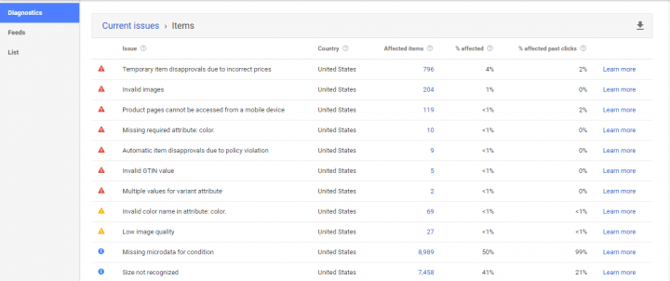
Go to your Item issues in the Diagnostics tab in Google Merchant Center and look for the errors, warnings and notifications on your every single one of the items in your feed.
We suggest you prioritize solving first the errors on all items, so that all your products become eligible for shopping campaigns.
We have two resources to help you fix those errors quick and fast:
- 10 Most common errors and disapprovals in Google Merchant Center
- How to fix your Google Shopping Feed Without Going Crazy is an exhaustive list of errors from Dennis at Store Growers.
2. Fix issues at a product level
Next, focus on solving the warnings and notifications for the products that have the best results.
Google has recently enhanced their reporting on Shopping campaigns so you can combine a product status report which shows which products need improvements with a performance report.
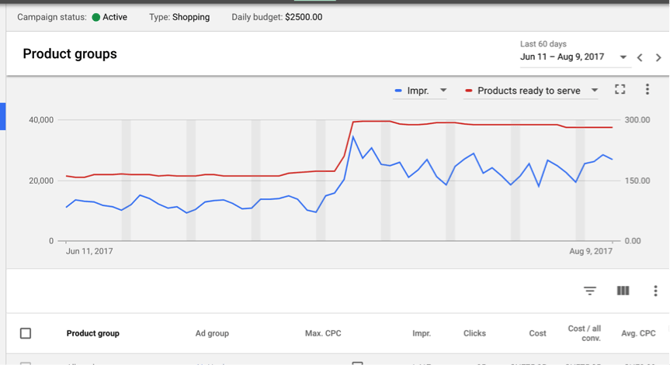
For example, you can add Clicks and Conversions data and decide which of the products with performance issues you need to improve first.
Eventually, you want to have all products in a good shape, but with the clock ticking you can focus your resources on the top 20% performers.
If you want to stay abreast with the latest updates rolled out this autumn by Google in the Merchant Center we’ve covered them all here:Google Shopping 2017 Updates.
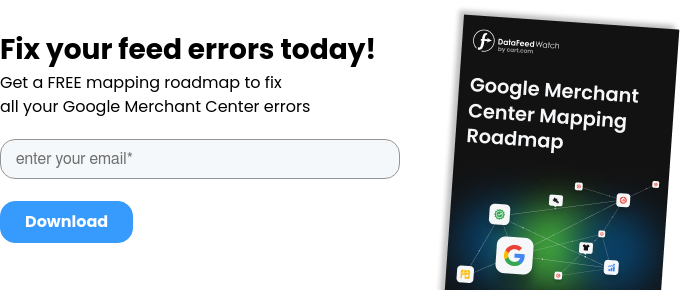
3. Check Impression and Click Share metrics
Impression share is the percentage of impressions a product has received divided by the estimated number of impressions that product was eligible to receive.
Click share shows the percentage of clicks on the products relative to the clicks they were eligible to receive.
Track Impression Share and Click Share together at product group level for the top performers or high-margin products and:
- If impression share is high and click share is low your products are showing for irrelevant search queries
- If impression share is low and click share is high you should increase the bids to receive more impressions
4. Improve Top Spot Impression Share
Check the Absolute Top Spot Impression Share for your best performing products.
This metric it shows the how many times a product was shown in a top position in the Google Shopping Carousel over the number of times your product was eligible for top impressions.
A top position refers to the leftmost spot in the Google Shopping carousel.
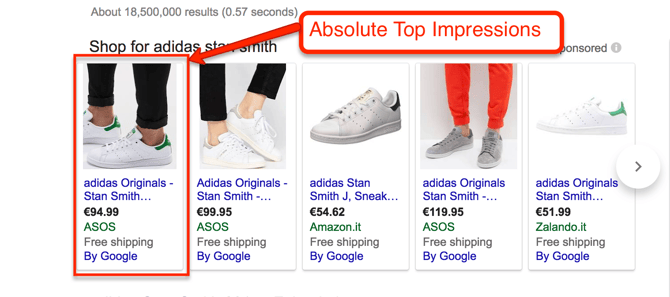
Things are expected to become even more interesting when data will be available on all positions in the carousel.
The competition for the Top Impression will likely result in increased bids, so it doesn’t make sense to compete for the top impression on all the products.
Sidecardoes a great job at explaining in details how to be strategic about the Absolute Top Spot Impression Share.
5. Take a look at last year's data
Look at historic data to see what has worked and what not. Use the reports to look for reusable keywords that you can reactivate, best performers, bid increases and other performance metrics.
It is very important that you use these insights to learn what has worked and not to base your budgets and predictions on last year performance.
Andrew Lolk, has done a great job at putting together alist of PPC itemsyou might want to review when looking historic performance.
6. Assess your feed's health
If you don’t know where to get started there are plenty of areas where improvements can have an immediate impact on the shopping campaign performance. So, before ironing out your feed improvement strategy go find out:
- Are your product titles search friendly and clickable?
- Are you using all the right keywords in the description?
- Are your prices accurate and updated? Make sure that the prices in the feed are similar to the ones on the product landing page and there are no 0$ values.
- Have you categorized your products at least 2-3 levels deep?
- Is the data accurate? Make sure that all out-of-stock items are handled with exclusion rules and submit intraday feed updates.
7. Prioritize your feed improvements
You’ve made a list of the products that need improvements, and now you’re just realizing that there’s only so much that you can do.
If scalability is a problem, add another layer and on top of focusing on your top 10-20% of the SKUs focus on the feed improvements that have the biggest impact on the bottom line: product titles, descriptions and feed frequency updates.
8. Improve product titles
There’s no shortage of tips, ideas and suggestions for title improvement in Google Shopping. If it keeps coming out, again and again, is because it does have a major impact on the performance.
Here are some quick tips for improving your titles:
- Create automation rules for titles based on the vertical of each product
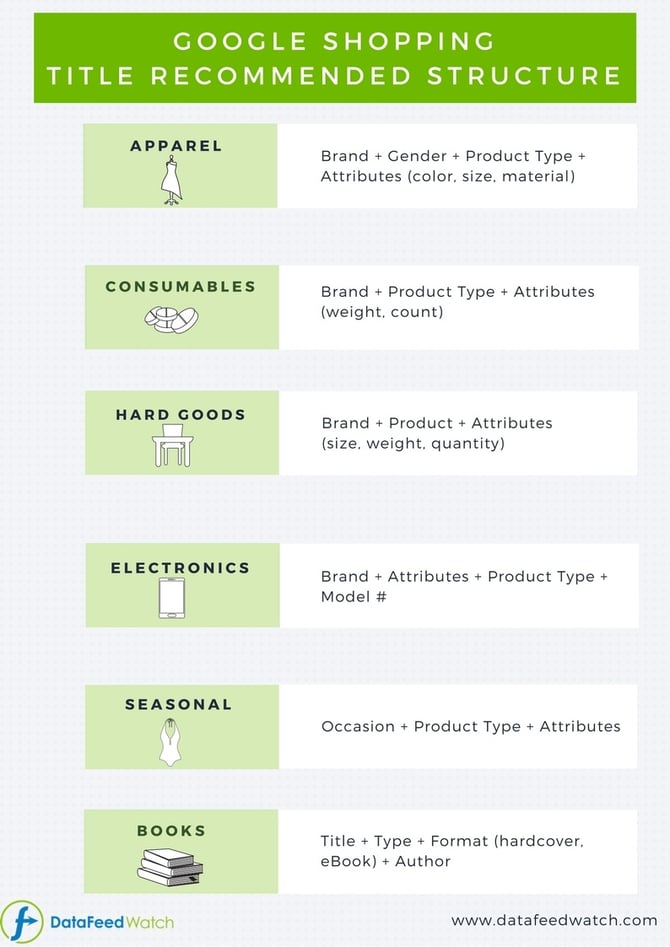
- Try and mimic customer language when writing the titles. The word order matters, and so ‘’white coat’’ will not be considered similar to ‘’coat white’'
- Brand should be included first in the title structure. The only exception is when the brand is not searched often, in which case it should be moved to the middle or end of the title
9. Improve the descriptions
Complete descriptions should include additional key information about the products that help capture new traffic.
Optimize your descriptions by using insights from shopping search term reports & keyword research tools. With the insights gathered you can recreate them so they match high traffic search terms more closely.
Data you should include in the product description is: brand, product type, size, shape, pattern, texture, material, age range, special features and technical information.
10. Increase the frequency of the feed updates
A feed update every 24 hours has become a best practice for online merchants. For Black Friday and the holiday season, frequent intraday updates are not only advisable, but paramount to making sure you don’t run into disapprovals.
If you want to learn more about the benefits of multiple feed updates we have outlined a number of reasons why it saves you time and headaches in this post: Multiple feed updates to increase profits.
You can submit intraday updates with the online product inventory update for these product data changes: prices, availability, sale price and sale price effective date.
There are multiple types of feeds that you can use in your Google Shopping Campaigns, so if you want to gain some clarity on which feed to use when go to: Google Shopping Feed Types.
Related: Automatic Item Updates in Google Merchant Center

Conclusion
With the holidays just around the corner now is the time to start testing and finding what works best for your vertical. These 10 tips should get you in good shape for Black Friday and Cyber Monday. By starting early, you will get a leg up on your competition.
If you think that there we overlooked some important tips please share them with us in the comments section below.